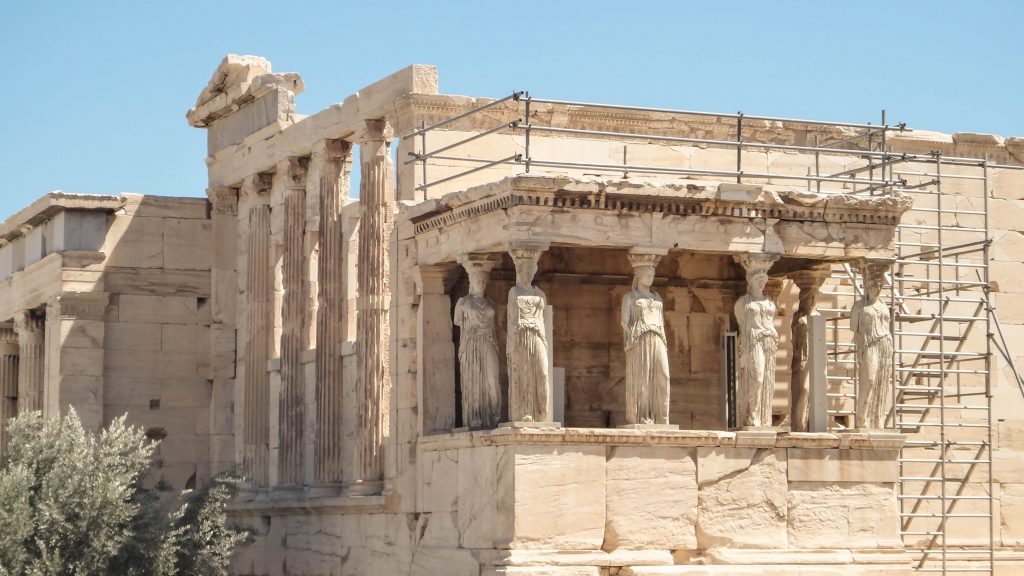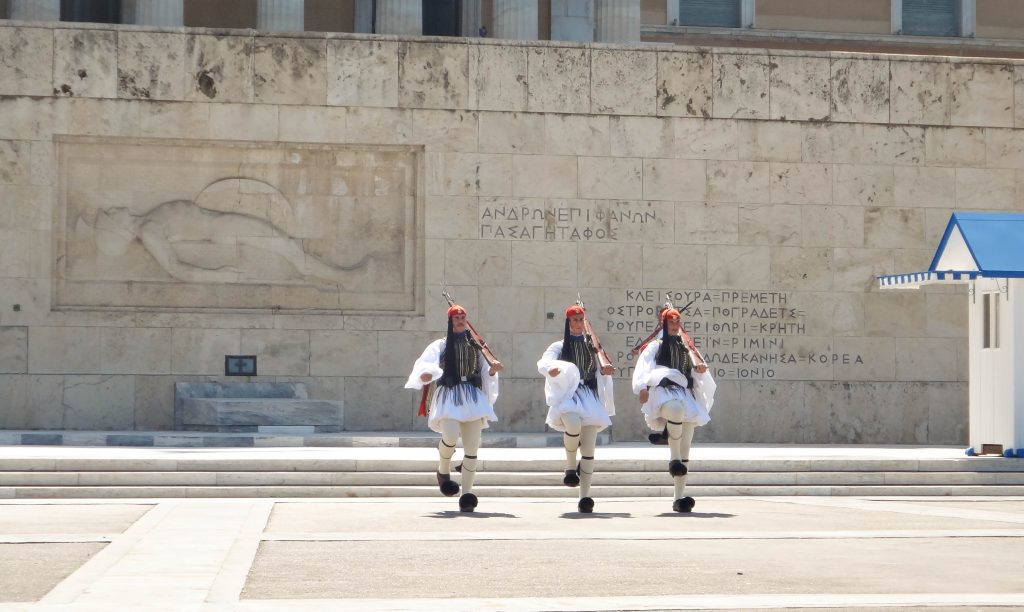Here it is another itinerary! This one is based on my 1-week family trip in Athens in the summer of 2015. This trip was not my first time in Athens. I had visited the city for a day when I was 7 as part of a 5-day cruise in the Aegean Sea, and when we were returning from Barcelona in 2012 and had a long layover in Athens. Both times we only managed to visit the city centre, so this time I wanted to see the city in more depth.
Disclosure: Please note that this post contains affiliate links. This means that if you click on a link marked with [AD] and proceed to make a purchase, I may earn a small commission at no extra cost to you.
The timing of the trip was and wasn’t so good. That time was the peak of the economic crisis in Greece, which meant huge riots and an early prime minister election. But, when we visited it was the week between the elections and an important deal. So, if you ignore the fact that all the banks were closed, the huge queues in ATMs that had little money to dispense and the uncertainty of the people for their future, the environment was fairly calm.
Back to the trip basics now. We stayed at the Astor Hotel [AD] close to the city centre and we generally moved around on foot and taxis since they were relatively cheap and more convenient than public transport.
Getting Ready for 1 Week in Athens
Length: 7 days
Time of the year: Summer – July
Suitable for: Families with teenagers
Difficulty: 1 | 1.5 | 2 | 2.5 | 3
Highlights: Mount
What to book in advance?
- Plane tickets and accommodation.
- Day cruise from Piraeus to Hydra – Poros – Aegina.
Day 1 – Arrival Day
Spend the morning to arrive in Athens and your accommodation before starting to explore the city.
Find out more about public transport in Athens here.
15:00 Syntagma Square
Start with a walk in of the most famous squares in Athens, Syntagma Square. It houses the Greek parliament at the impressive Old Royal Palace and holds an important place in modern green history. In front of the palace is the Tomb of the Unknown Soldier that is guarded by Evzones (soldiers of the Presidential guard wearing the “fustanella” uniforms). Every hour there is a change of guards in front of the monument. There is a complete change of guards where soldiers are wearing their full traditional uniforms every Sunday at 11 pm. From Syntagma square starts one of the main shopping streets in Athens, Ermou Square.
How to get there?
There are a number of ways that you can reach Syntagma Square, as it is one of the main transportation hubs in Athens. You can take metro lines M2 and M3 and get off at Syntagma Stop (ΣΤ. ΣΥΝΤΑΓΜΑΤΟΣ). Buses 227, 230, 790, 856, A2, A3, B2, E14, X14 stop by Syntagma as well as trolleybuses 1, 2, 4, 5, 11 and trams T4 and T5.
17:00 Mount Lycabettus
Go for an evening walk in Mount Lycabettus to have amazing views of the city. Go a little bit later to enjoy a beautiful sunset over Athens.
How to get there (from Syntagma Square)?
In general, there are many ways to ascend the hill. The easiest being taking the funicular from Aristippou Street in Kolonaki. Be careful as it may be easily missed. The funicular is about 15 minutes on foot from Syntagma Square or 10 minutes on foot from Evagelismos Station (ΣΤ. ΕΥΑΓΓΕΛΙΣΜΟΥ) that is one metro stop away from Syntagma on the M3 line.
Hiking up the hill is also an option and also provides great views over the city. Take care to choose the side of the hill that does not have direct sunlight, i.e. for this time of the day during summer, the east side would be better.
What happened in our case was that we were looking for the funicular to get up but, apparently, we were walking on the parallel street so we missed it. When we reached the end of the road we were walking and there was no funicular to be seen, we decided to ask a local who told us that we had to go back and turn left to get to the funicular. A better way, he told us, would be to ascend the hill on foot as it is only five minutes away. Ok, five minutes are not much we can do it. Guess what? It took us a good 30 minutes to reach the top on the west side of the hill. Amazing! To be honest, I did enjoy the hike because the views were so good on that side.
Day 2 – Ancient Greece Day

9:00 Ancient Agora of Athens
Start the day today at the Ancient Agora of Athens, which is the first stop of the list of ancient monuments in the city. Agora used to be a public space where people gathered to perform various activities. Spend some time walking around and learning about the usage of each part of the Agora. Complete your tour by visiting the Museum of the Ancient Agora that is located inside the Stoa of Attalos.
How to get there?
The entrance to the site is located on Andrianou Street an can be reached by metro lines M1 from Thissio station (ΣΤ. ΘΗΣΣΕΙΟ) and M1 or M3 from Monastiraki station (ΣΤ. ΜΟΝΑΣΤΗΡΑΚΙ) or by bus 25, 26, 27, 35, 100 and 227.
Find more about the Museum of the Ancient Agora here.
10:00 Acropolis of Athens
Continue the exploration of Ancient Athens by visiting the Acropolis of Athens. Climb up the hill to the world famous Parthenon and marvel around the ruins of the other buildings that used to constitute this ancient citadel. There are more than 20 archaeologically interesting sites in the area so make sure to allow plenty of time to explore (along with the numerous other tourists).
How to get there (from the Ancient Agora of Athens)?
The two archaeological sites are only a 15-minute walk apart. Also, the Acropolis can easily be reached by metro line M2 from Acropolis Station (ΣΤ. ΑΚΡΟΠΟΛΗ) and M1 or M3 from Monastiraki Station (ΣΤ. ΜΟΝΑΣΤΗΡΑΚΙ).
Find out more about the Acropolis here.
11:30 Acropolis Museum
At the foot of the Acropolis hill is the Museum of Acropolis which is definitely worth a visit. It includes fascinating details about Ancient Greece in a modern environment. Even if you choose not to visit the archaeological site of Acropolis I totally recommend visiting the museum.
How to get there (from Acropolis of Athens)?
The museum is a 10-minute walk from the entrance to Acropolis.
Find out more about the Acropolis Museum here.
14:00 The Temple of Olympian Zeus
After lunch (when we visited we had lunch at the Acropolis Museum), spend some time at the Temple of Olympian Zeus, also known as Olympieion. It combines ruins both from ancient Greek and the Roman era. Don’t miss the Hadrian’s Arch, located on the perimeter of the site.
How to get there (from the Acropolis Museum)?
The archaeological site of Olympieion is only 5 minutes away on foot from the Acropolis Museum.
Find out more about the Temple of Olympian Zeus here.
15:00 The Panathenaic Stadium
Finish exploring the archaeological sites of Ancient Greece with a visit to the Panathenaic Stadium, also known as Kallimarmaro. The stadium hosted gymnastic games for the first time circa 500BC and continued to do so until modern times. A recent example was during the 2004 Olympic Games that were held in Athens.
How to get there (from Olympieion)?
Kallimarmaro is between 10 and 15 minutes away on foot from the Olympieion. Don’t forget to pass by the Temple of Artemis Agrotera on your way there.
Find out more about the Panathenaic Stadium here.
16:30 National Archaeological Museum
Wrap up your day with a visit to the National Archaeological Museum, the largest museum in Greece. The museum stays open at 8 pm during the summer, so you have plenty of time to explore. It houses important finds of the excavations not only in Athens but also from various locations in Greece.
How to get there (from the Panathenaic Stadium)?
The quickest way to reach the National Archaeological Museum from the Panathenaic Stadium is to take the trolleybus 2 from Stadio and get off at Polytechneio. The total trolleybus trip should last about 10 minutes.
Find more about the museum here.
Day 3 – Shopping Day
10:00 Ermou Street
Take a break from sightseeing and indulge in shopping. Start from Ermou, the main shopping street in Athens and make your way up. On the way you will come across many local and international shops.
I suggest that you start from the Thessio site of the street and make your way up to Syntagma Square, then turn in the Panepistimiou Avenue, where you can visit the Attica department store home to many designer brands. Walk your way along Panepistimiou Avenue and pass in front of the University of Athens (Panepistimio) and the National Library of Greece. Walk until you reach Omonia Square, where you can find more affordable local shops.
Alternative 1: Instead of walking up to Omonia Square, after reaching Syntagma square turn to Vasilissis Sofias Avenue and then turn again into one of the small streets on your right to reach the Kolonaki area. Kolonaki is famous for its high-end designer shops.
Alternative 2: If you want to avoid the heat of the street visit one of the many indoor shopping malls in Athens such as The Mall of Athens (one of the largest in Southeastern Europe) or the Golden Hall.
How to get there?
To get to the Thessio part of Ermou Street you can get of at Thessio metro station (ΣΤ. ΘΗΣΕΙΟΥ) using line M1 or you can get off at ISAP Thessiou bus stop using buses 25, 26, 27, 35, 227 or 500. If you want to get to the Syntagma Square end of Ermou Street you can follow the instructions to Syntagma Square from Day 1.
19:00 Psyri
Spend the evening in Psyri, one of the many Athenian neighbourhoods famous for their food and nightlife.
How to get there?
You can arrive at Psyri by metro or by bus. You can use Thessio metro station (ΣΤ. ΘΗΣΕΙΟΥ) using line M1 or Monastiraki station (ΣΤ. ΜΟΝΑΣΤΗΡΑΚΙ) using lines M1 or M3. The buses that service the area include 25, 26, 27, 35, 227, 500 that stop at Boreou stop, Monastiraki stop and Isap Thessiou stop.
Day 4 – Islands Day

7:30 Piraeus Port
Take a day cruise to visit the Saronic Islands of Hydra, Poros and Aegina. There are different companies that offer cruises to the Saronic Islands (Salamina, Aegina, Agkistri, Hydra, Poros, Spetses and Dokos). Check your day cruise departure time and make sure to arrive early at the port.
Note: The following times are based on the cruise that we had chosen. Times for other companies may vary.
Alternative 1: You can choose another combination of islands if you prefer. Different companies service different islands
Alternative 2: Choose a nearby island and go for a day trip there. There are many islands that can be visited from Athens in 2-3 hours. The ship may depart either from Piraeus or Rafina port (if going to an island in the Cyclades).
Do you want to spend more days in the Greek Islands, but don’t want to spend an insane amount of money? Then, check out: 10 Tips for Visiting the Greek Islands on a Budget.
How to get there?
You can take metro M1 to Piraeus (ΣΤ. ΠΕΙΡΑΙΑΣ), then the port should be a few minutes away depending on where you are going. When we visited, we used a taxi to go to the port as it would take less time overall and we didn’t want to be in a hurry since our ship left at 8 am.
11:00 Hydra
Spend some time walking in the streets of car-free Hydra or take a donkey ride!
14:00 Poros
Climb up the steps to the Clock of Poros to enjoy amazing views over the Saronic Gulf.
16:00 Aegina
Taste the delicious pistachio treats made from some of the world’s best pistachios. You can also visit the church of St Nectarios (but you will a taxi to get there) or take the boat and go nearby Agkistri (10-minute boat ride) for a quick dip in the sea.
Buy your Hydra-Poros-Aegina day cruise from Viator [AD].
Day 5 – Nafplio Day

12:00 Nafplio
Take another day off Athens to explore a nearby city in Peloponnese, Nafplio the first capital of model day Greece. Once there spend some time walking in the city centre, pass by the first pharmacy of Greece, the statue of Otto, the church of St. Spyridon where you can see the place that the first governor of Greece was killed (marked with a bullet hole on the wall), the first building of the Greek parliament called the Vouleftikon, before going for lunch in one of the many restaurants there.
Alternative 1: You can combine your day trip to Nafplion to include other nearby Peloponnesian cities of historical significance such as Epidauros, Mycenae and Corinth.
Alternative 2: There are many cities that can be visited as a day trip from Athens. Historical Delphi and Sounion were both included in our list.
How to get there?
Nafplio is 1 hour and 45 minutes away from Athens by car. If you don’t have access to a car, then you can use the bus (KTEL Argolidas) from Kifissos Bus Station. There is a direct service almost every hour but it is better to check the website for exact timings and prices.
Buy your Peloponnesos day trip from Viator [AD].
14:00 Kompoloi Museum
This small museum features a unique collection of komplois (rosaries). Their collection features different of rosaries, beads and strings along with some history. Their shop on the ground floor has a range of kompolois on sale many of which are made in their workshop!
Alternative: There a few more museums in the city centre which instead or in addition to the Komploi Museum, like the Archeological Museum of Nafplio, the War Museum Nafplio, the Peloponnesian Folklore Foundation and the National Gallery – Nafplio Departement.
How to get there (from Nafplio city centre)?
The museum is located in Staikopoulou street, so simply walk your way from where you will be.
Find out more about the Kompoloi Museum here.
15:00 Fortress of Palamidi
This fortress build on a hill is famous for having “accommodated” a hero of the Greek Revolution, Theothoros Kolokotronis. His prison can be found in one of the two bastions of the castle that still exist today (the one named Miltiades). The other bastion is a church to St. Andrews. Before leaving don’t forget to marvel the views over Naflio and the Argosaronic Gulf.
Alternative: You can visit the Akronafplia’s Castle which is only a short 15-minute walk from the city centre.
How to get there (from the Kompoloi Museum)?
The fortress is not accessible by public transport (at least that what Google Maps says), so the best way to get there if you want to avoid walking for an hour in the midday sun is to get a taxi. This is how we visited we visited the place and we also arranged for a time with the taxi driver to meet us to take us back to the city centre.
Find out more about the Fortress of Palamidi here.
16:30 Nafplio Harbour
Return to the city centre and have an evening stroll in the harbour, passing by the lighthouse and the Five Brothers Cannons. You can then rest at one of the cafes in Boumpoulinas Street overlooking the Bourtzi Castle, a Venetian structure located on a small island opposite Nafplio. If you want, you can take a boat from the harbour and visit the island.
How to get there (from the Fortress of Palamidi)?
The quickest and easiest way to get from Palamidi to the port is to get a taxi.
18:00 Nafplio Bus Station
Make your way to the bus stop to return to Athens. Remember to check the website for the most recent route information.
How to get there (from the Nafplio Harbour)?
The bus station is a 10-minute walk from the harbour.
Day 6 – Athenian Neighbourhoods Day
10:00 Monastiraki
Have a leisure morning walk in the Monastiraki area, visiting the Monastiraki Flea Market. At Monastiraki, you can also find the ruins of Hadrian’s Library and the Museum of Ceramics. Spend some time walking around the smalls street that eventually lead to Thessio, admiring the Parthenon and the ruins of the Ancient Agora along the way.
How to get there?
Get off at Monastiraki metro station (ΣΤ. ΜΟΝΑΣΤΗΡΑΚΙ) using lines M1 or M3 or use one of the buses that service the area include 25, 26, 27, 35, 227, 500 that stop at Monastiraki.
13:00 Plaka
Have lunch at one of the many restaurants in Plaka neighbourhood and walk in the picturesque Anafiotika, a small neighbourhood in the older part of Plaka. After you are done don’t forget to pass by the Choragic Monument of Lysicrates or visit the Museum of Greek Folk Art.
How to get there (from Monastiraki)?
Plaka is a 10-minute walk from Monastiraki and a 15-minute walk from Thessio if you end up there in the morning.
15:00 National Garden
Spend your afternoon at the National Garden, a public park right behind the Syntagma Square. Here you can find the Zappio Hall, the Third Ephorate Of Ancient Antiquities and a statue of Lord Byron.
Alternative: Spend a couple of hours in the Keramikos area. You can visit the Keramikos archaeological site and the nearby Museum of Keramikos. Alternative visit an exhibition in one of the art galleries in the area.
How to get there (from Plaka)?
The National Garden is a 10-minute walk from Plaka.
Find out more about Keramikos archaeological site here.
17:00 Allou! Fun Park
Spend your last evening in Athens in this attraction park that features funfair rides for all ages. The park is only open during the evenings so it’s ideal for staying until late.
Alternative: If attraction parks are not for you then why don’t you head to Filopappou Hill to enjoy views over the Acropolis and Athens. The hike to the top of the hill should be an easy one. Once there, don’t forget to pass by the Monument of Filopappos and the Prison of Socrates.
How to get there (from National Garden)?
Take the metro line M3 from Syntagma Square (ΣΤ. ΣΥΝΤΑΓΜΑΤΟΣ) and get off at Aegaleo (ΣΤ. ΑΙΓΑΛΕΩ). From there you need to take bus 829 from Estauromenos stop to KAN KAN or bus 820 from Estauromenos stop to Gephyra. From both stations Allou! Fun Park is only a few minutes away on foot.
Find out more about Allou! Fun Park here.
Day 7 – Departure Day

Depending on your time you may want to visit one of the many other interesting attractions in Athens. You can visit the Benaki Museum at Vasilissis Sofias Avenue, a museum of art and history that spans along different time periods; the Byzantine and Christian Museum; or the recently opened Museum of Illusions.
Find out more about the Benaki Museum here, the Byzantine and Christian Museum here and the Museum of Illusions here.
Kalo Taxidi!
P.S. Who could imagine that after not liking Athens that much – that’s why it was not on my list up to that time – (referring to its lifestyle, not its historical significance or attractions), I would revisit it two months after that trip. A third visit was up the following year. Just to clarify here, Athens is a great city, but it’s not for me. I prefer the lifestyle of central Europe.
Did you like this post? Save it for later!




